Zara: Impact of Org Culture on Diversity Management Practices Research
VerifiedAdded on 2023/06/07
|30
|7681
|252
Report
AI Summary
This research project investigates the impact of organizational culture on diversity management practices, focusing on Zara as a case study. It begins with an overview of Zara, identifying key issues like e-commerce, competition, and sustainability. The project aims to enhance understanding of organizational culture and diversity management, identify relevant models and practices within Zara, assess the impact of organizational culture on diversity management over three months, and recommend strategies for building a positive, diverse workforce. The literature review covers organizational culture, diversity management, models, and the impact of culture on diversity practices, along with strategies for fostering a diverse workforce. The project employs a specific methodology, considers ethical implications, and outlines the scope and limitations. Data analysis presents findings related to Zara's diversity management, culminating in conclusions and recommendations for Zara to improve its diversity and inclusion efforts. The study concludes with personal reflections from the researcher.
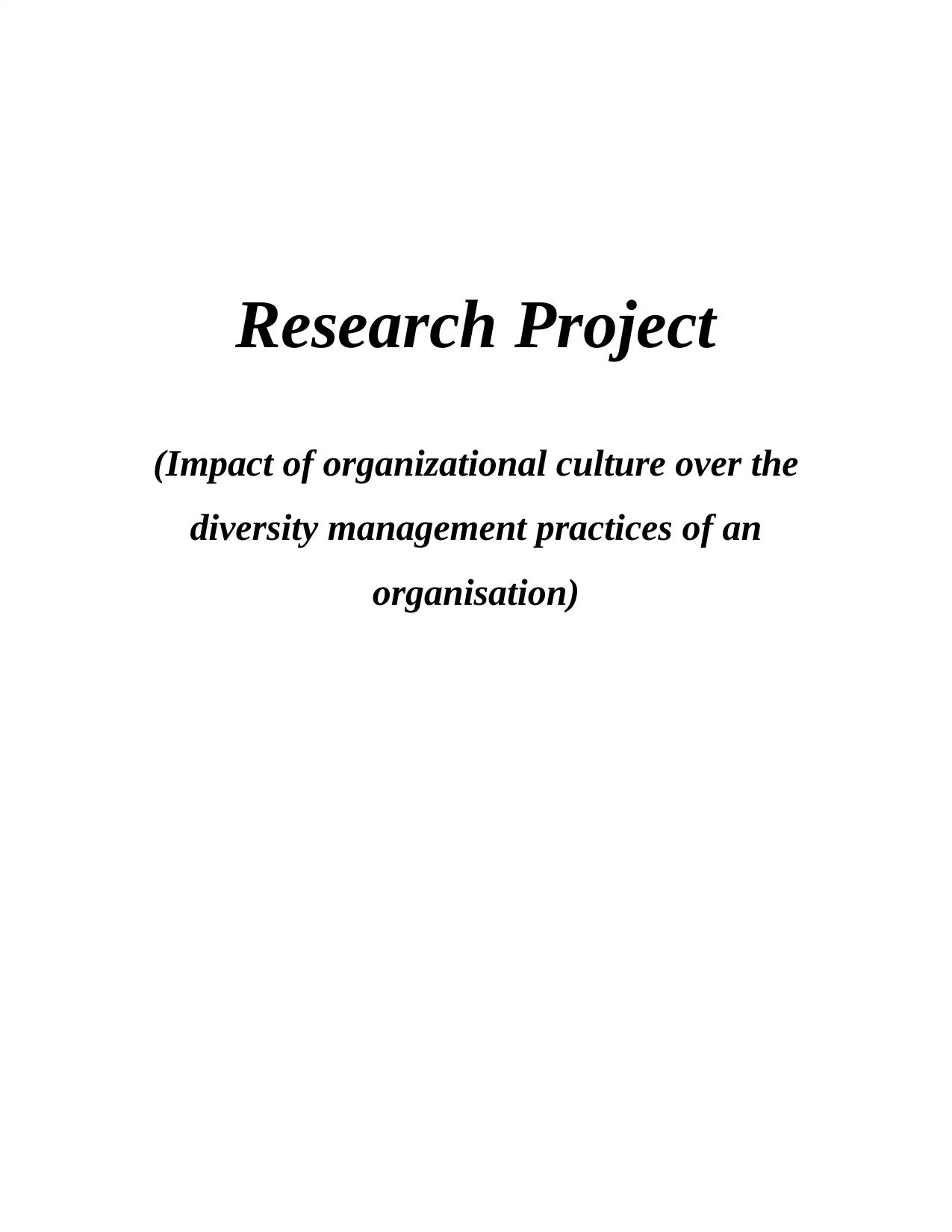
Research Project
(Impact of organizational culture over the
diversity management practices of an
organisation)
(Impact of organizational culture over the
diversity management practices of an
organisation)
Paraphrase This Document
Need a fresh take? Get an instant paraphrase of this document with our AI Paraphraser

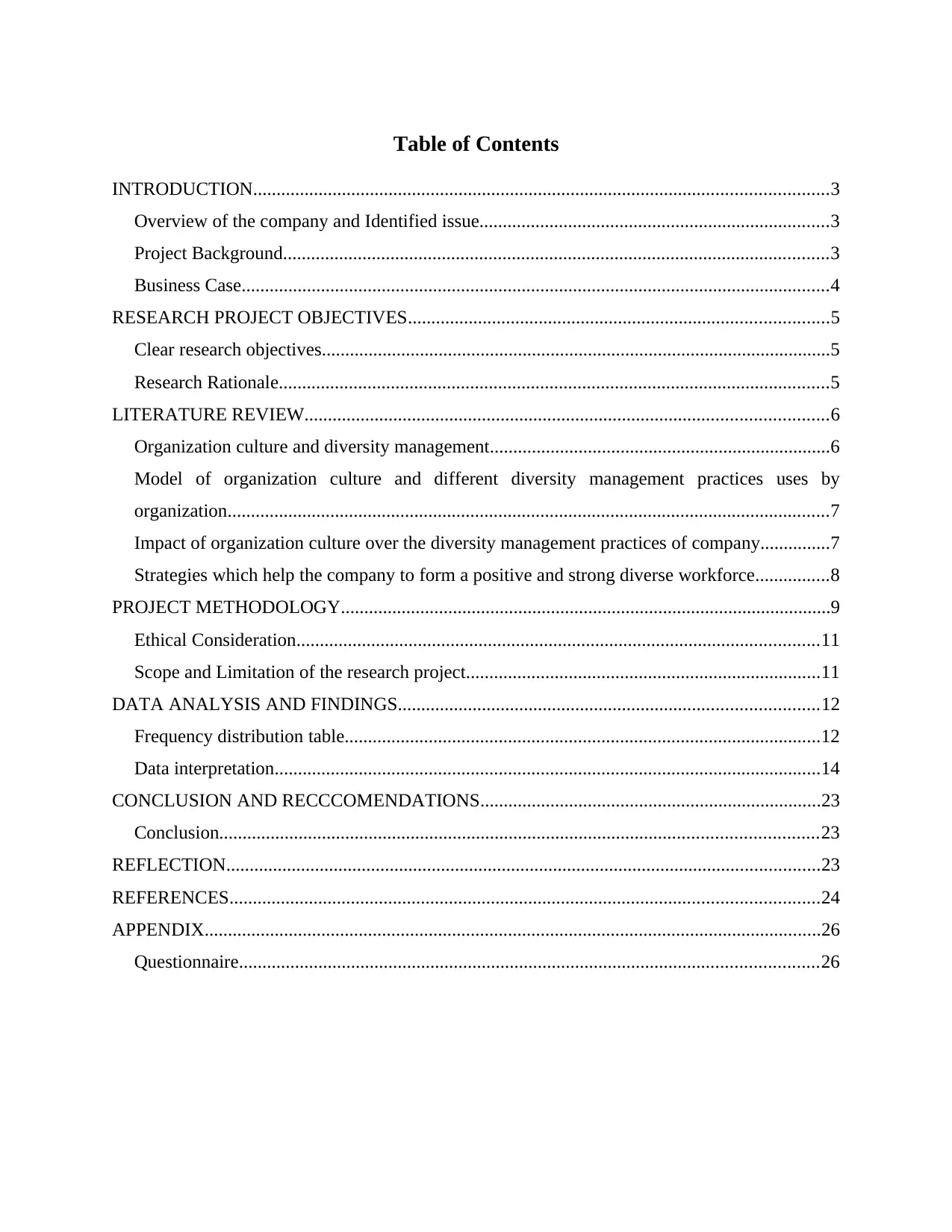
Table of Contents
INTRODUCTION...........................................................................................................................3
Overview of the company and Identified issue...........................................................................3
Project Background.....................................................................................................................3
Business Case..............................................................................................................................4
RESEARCH PROJECT OBJECTIVES..........................................................................................5
Clear research objectives.............................................................................................................5
Research Rationale......................................................................................................................5
LITERATURE REVIEW................................................................................................................6
Organization culture and diversity management.........................................................................6
Model of organization culture and different diversity management practices uses by
organization.................................................................................................................................7
Impact of organization culture over the diversity management practices of company...............7
Strategies which help the company to form a positive and strong diverse workforce................8
PROJECT METHODOLOGY.........................................................................................................9
Ethical Consideration................................................................................................................11
Scope and Limitation of the research project............................................................................11
DATA ANALYSIS AND FINDINGS..........................................................................................12
Frequency distribution table......................................................................................................12
Data interpretation.....................................................................................................................14
CONCLUSION AND RECCCOMENDATIONS.........................................................................23
Conclusion................................................................................................................................23
REFLECTION...............................................................................................................................23
REFERENCES..............................................................................................................................24
APPENDIX....................................................................................................................................26
Questionnaire............................................................................................................................26
INTRODUCTION...........................................................................................................................3
Overview of the company and Identified issue...........................................................................3
Project Background.....................................................................................................................3
Business Case..............................................................................................................................4
RESEARCH PROJECT OBJECTIVES..........................................................................................5
Clear research objectives.............................................................................................................5
Research Rationale......................................................................................................................5
LITERATURE REVIEW................................................................................................................6
Organization culture and diversity management.........................................................................6
Model of organization culture and different diversity management practices uses by
organization.................................................................................................................................7
Impact of organization culture over the diversity management practices of company...............7
Strategies which help the company to form a positive and strong diverse workforce................8
PROJECT METHODOLOGY.........................................................................................................9
Ethical Consideration................................................................................................................11
Scope and Limitation of the research project............................................................................11
DATA ANALYSIS AND FINDINGS..........................................................................................12
Frequency distribution table......................................................................................................12
Data interpretation.....................................................................................................................14
CONCLUSION AND RECCCOMENDATIONS.........................................................................23
Conclusion................................................................................................................................23
REFLECTION...............................................................................................................................23
REFERENCES..............................................................................................................................24
APPENDIX....................................................................................................................................26
Questionnaire............................................................................................................................26
⊘ This is a preview!⊘
Do you want full access?
Subscribe today to unlock all pages.

Trusted by 1+ million students worldwide
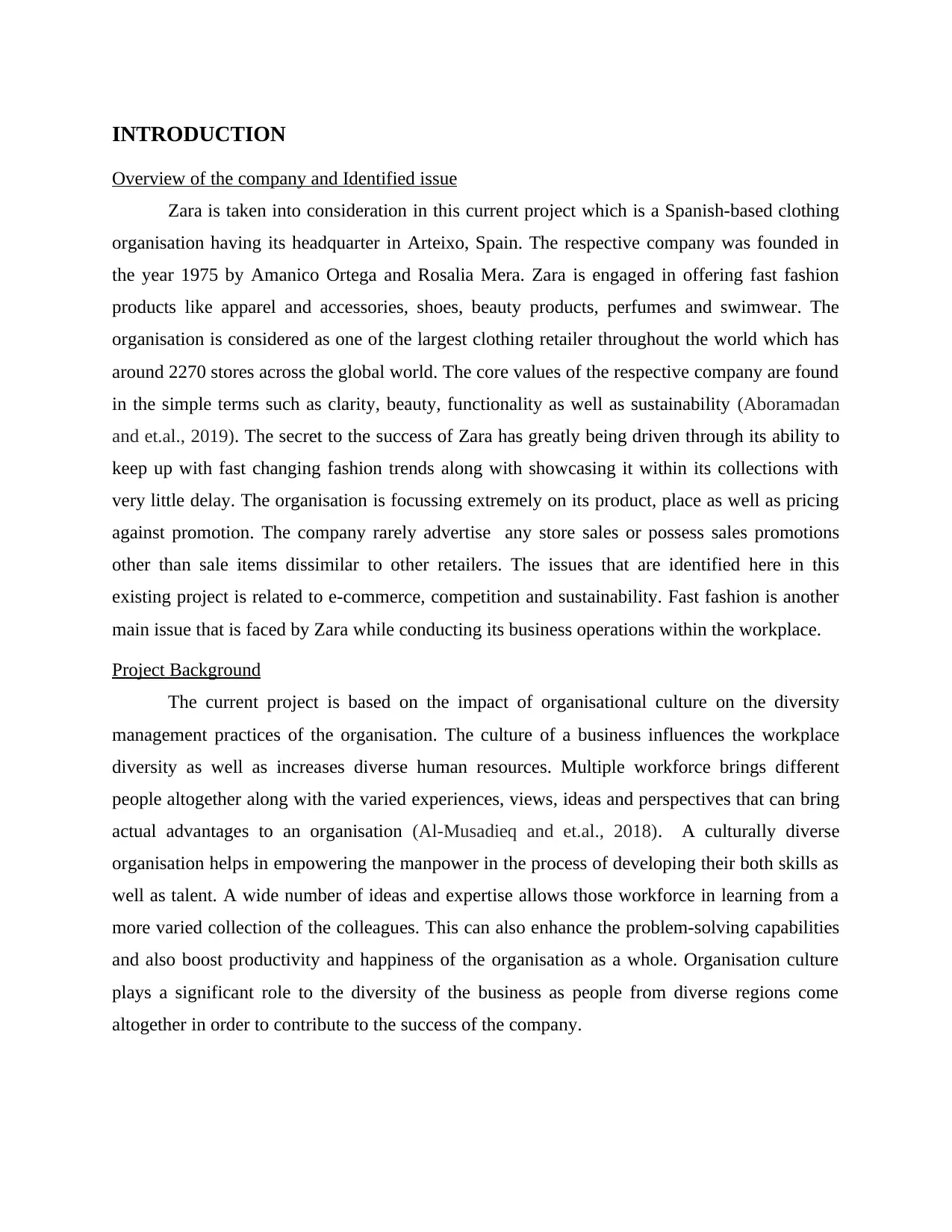
INTRODUCTION
Overview of the company and Identified issue
Zara is taken into consideration in this current project which is a Spanish-based clothing
organisation having its headquarter in Arteixo, Spain. The respective company was founded in
the year 1975 by Amanico Ortega and Rosalia Mera. Zara is engaged in offering fast fashion
products like apparel and accessories, shoes, beauty products, perfumes and swimwear. The
organisation is considered as one of the largest clothing retailer throughout the world which has
around 2270 stores across the global world. The core values of the respective company are found
in the simple terms such as clarity, beauty, functionality as well as sustainability (Aboramadan
and et.al., 2019). The secret to the success of Zara has greatly being driven through its ability to
keep up with fast changing fashion trends along with showcasing it within its collections with
very little delay. The organisation is focussing extremely on its product, place as well as pricing
against promotion. The company rarely advertise any store sales or possess sales promotions
other than sale items dissimilar to other retailers. The issues that are identified here in this
existing project is related to e-commerce, competition and sustainability. Fast fashion is another
main issue that is faced by Zara while conducting its business operations within the workplace.
Project Background
The current project is based on the impact of organisational culture on the diversity
management practices of the organisation. The culture of a business influences the workplace
diversity as well as increases diverse human resources. Multiple workforce brings different
people altogether along with the varied experiences, views, ideas and perspectives that can bring
actual advantages to an organisation (Al-Musadieq and et.al., 2018). A culturally diverse
organisation helps in empowering the manpower in the process of developing their both skills as
well as talent. A wide number of ideas and expertise allows those workforce in learning from a
more varied collection of the colleagues. This can also enhance the problem-solving capabilities
and also boost productivity and happiness of the organisation as a whole. Organisation culture
plays a significant role to the diversity of the business as people from diverse regions come
altogether in order to contribute to the success of the company.
Overview of the company and Identified issue
Zara is taken into consideration in this current project which is a Spanish-based clothing
organisation having its headquarter in Arteixo, Spain. The respective company was founded in
the year 1975 by Amanico Ortega and Rosalia Mera. Zara is engaged in offering fast fashion
products like apparel and accessories, shoes, beauty products, perfumes and swimwear. The
organisation is considered as one of the largest clothing retailer throughout the world which has
around 2270 stores across the global world. The core values of the respective company are found
in the simple terms such as clarity, beauty, functionality as well as sustainability (Aboramadan
and et.al., 2019). The secret to the success of Zara has greatly being driven through its ability to
keep up with fast changing fashion trends along with showcasing it within its collections with
very little delay. The organisation is focussing extremely on its product, place as well as pricing
against promotion. The company rarely advertise any store sales or possess sales promotions
other than sale items dissimilar to other retailers. The issues that are identified here in this
existing project is related to e-commerce, competition and sustainability. Fast fashion is another
main issue that is faced by Zara while conducting its business operations within the workplace.
Project Background
The current project is based on the impact of organisational culture on the diversity
management practices of the organisation. The culture of a business influences the workplace
diversity as well as increases diverse human resources. Multiple workforce brings different
people altogether along with the varied experiences, views, ideas and perspectives that can bring
actual advantages to an organisation (Al-Musadieq and et.al., 2018). A culturally diverse
organisation helps in empowering the manpower in the process of developing their both skills as
well as talent. A wide number of ideas and expertise allows those workforce in learning from a
more varied collection of the colleagues. This can also enhance the problem-solving capabilities
and also boost productivity and happiness of the organisation as a whole. Organisation culture
plays a significant role to the diversity of the business as people from diverse regions come
altogether in order to contribute to the success of the company.
Paraphrase This Document
Need a fresh take? Get an instant paraphrase of this document with our AI Paraphraser
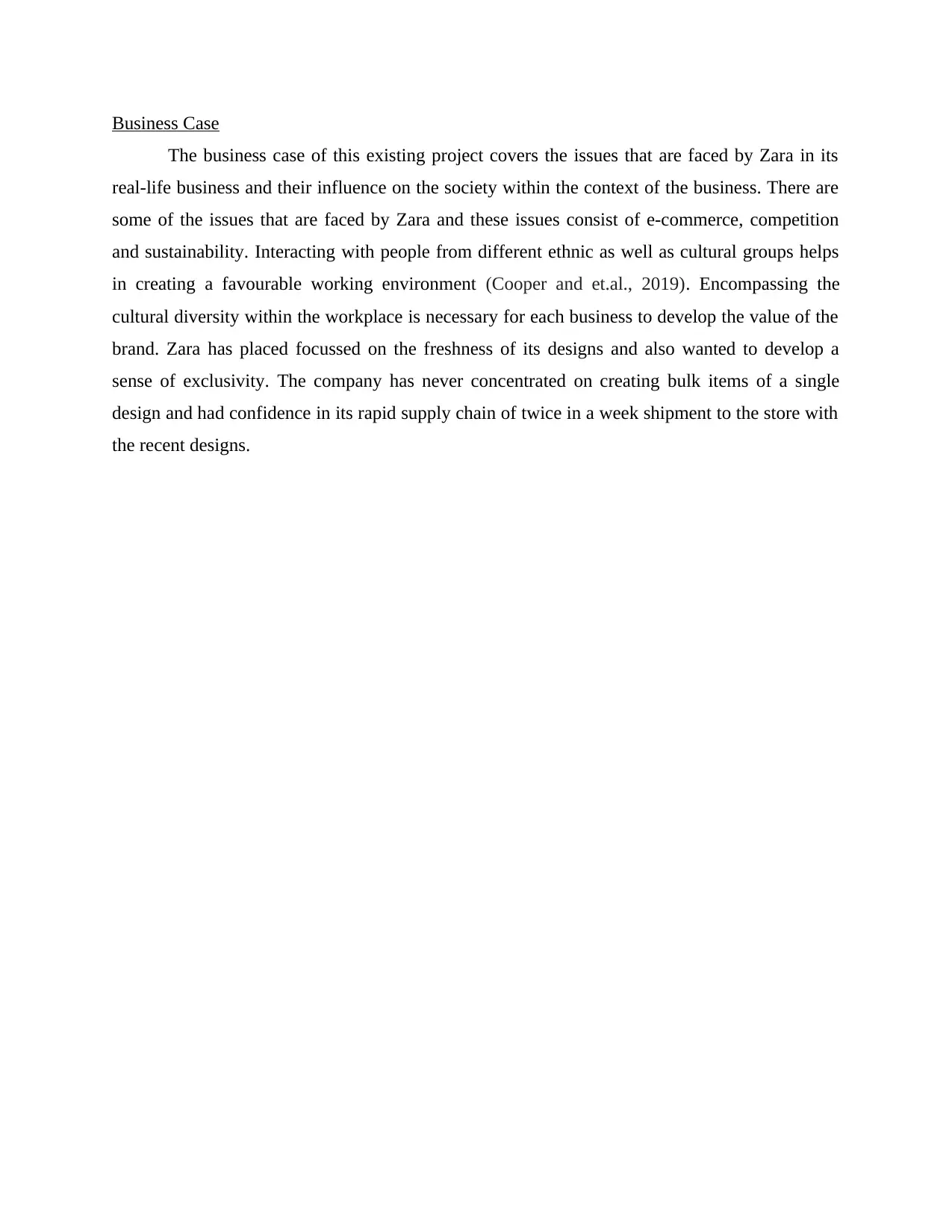
Business Case
The business case of this existing project covers the issues that are faced by Zara in its
real-life business and their influence on the society within the context of the business. There are
some of the issues that are faced by Zara and these issues consist of e-commerce, competition
and sustainability. Interacting with people from different ethnic as well as cultural groups helps
in creating a favourable working environment (Cooper and et.al., 2019). Encompassing the
cultural diversity within the workplace is necessary for each business to develop the value of the
brand. Zara has placed focussed on the freshness of its designs and also wanted to develop a
sense of exclusivity. The company has never concentrated on creating bulk items of a single
design and had confidence in its rapid supply chain of twice in a week shipment to the store with
the recent designs.
The business case of this existing project covers the issues that are faced by Zara in its
real-life business and their influence on the society within the context of the business. There are
some of the issues that are faced by Zara and these issues consist of e-commerce, competition
and sustainability. Interacting with people from different ethnic as well as cultural groups helps
in creating a favourable working environment (Cooper and et.al., 2019). Encompassing the
cultural diversity within the workplace is necessary for each business to develop the value of the
brand. Zara has placed focussed on the freshness of its designs and also wanted to develop a
sense of exclusivity. The company has never concentrated on creating bulk items of a single
design and had confidence in its rapid supply chain of twice in a week shipment to the store with
the recent designs.
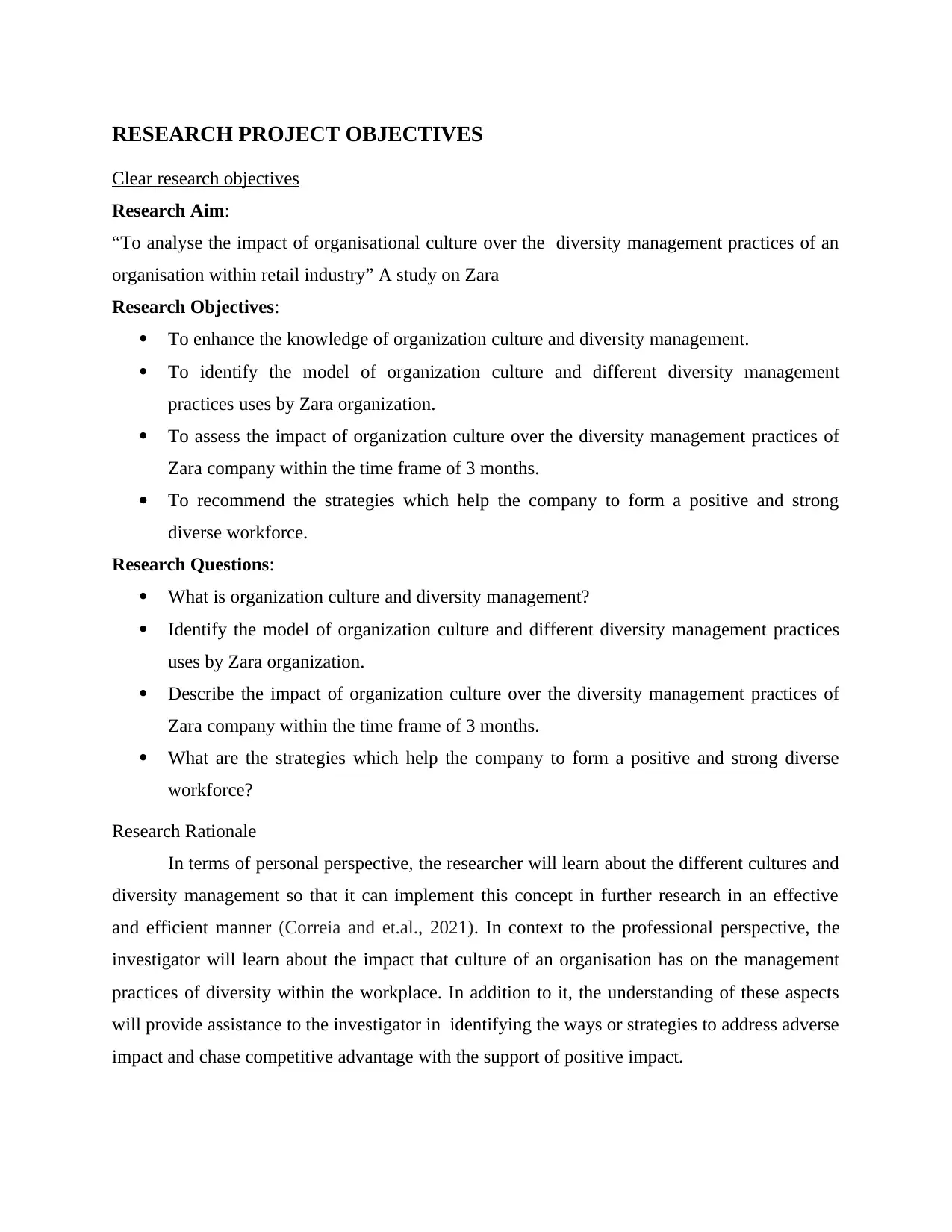
RESEARCH PROJECT OBJECTIVES
Clear research objectives
Research Aim:
“To analyse the impact of organisational culture over the diversity management practices of an
organisation within retail industry” A study on Zara
Research Objectives:
To enhance the knowledge of organization culture and diversity management.
To identify the model of organization culture and different diversity management
practices uses by Zara organization.
To assess the impact of organization culture over the diversity management practices of
Zara company within the time frame of 3 months.
To recommend the strategies which help the company to form a positive and strong
diverse workforce.
Research Questions:
What is organization culture and diversity management?
Identify the model of organization culture and different diversity management practices
uses by Zara organization.
Describe the impact of organization culture over the diversity management practices of
Zara company within the time frame of 3 months.
What are the strategies which help the company to form a positive and strong diverse
workforce?
Research Rationale
In terms of personal perspective, the researcher will learn about the different cultures and
diversity management so that it can implement this concept in further research in an effective
and efficient manner (Correia and et.al., 2021). In context to the professional perspective, the
investigator will learn about the impact that culture of an organisation has on the management
practices of diversity within the workplace. In addition to it, the understanding of these aspects
will provide assistance to the investigator in identifying the ways or strategies to address adverse
impact and chase competitive advantage with the support of positive impact.
Clear research objectives
Research Aim:
“To analyse the impact of organisational culture over the diversity management practices of an
organisation within retail industry” A study on Zara
Research Objectives:
To enhance the knowledge of organization culture and diversity management.
To identify the model of organization culture and different diversity management
practices uses by Zara organization.
To assess the impact of organization culture over the diversity management practices of
Zara company within the time frame of 3 months.
To recommend the strategies which help the company to form a positive and strong
diverse workforce.
Research Questions:
What is organization culture and diversity management?
Identify the model of organization culture and different diversity management practices
uses by Zara organization.
Describe the impact of organization culture over the diversity management practices of
Zara company within the time frame of 3 months.
What are the strategies which help the company to form a positive and strong diverse
workforce?
Research Rationale
In terms of personal perspective, the researcher will learn about the different cultures and
diversity management so that it can implement this concept in further research in an effective
and efficient manner (Correia and et.al., 2021). In context to the professional perspective, the
investigator will learn about the impact that culture of an organisation has on the management
practices of diversity within the workplace. In addition to it, the understanding of these aspects
will provide assistance to the investigator in identifying the ways or strategies to address adverse
impact and chase competitive advantage with the support of positive impact.
⊘ This is a preview!⊘
Do you want full access?
Subscribe today to unlock all pages.

Trusted by 1+ million students worldwide
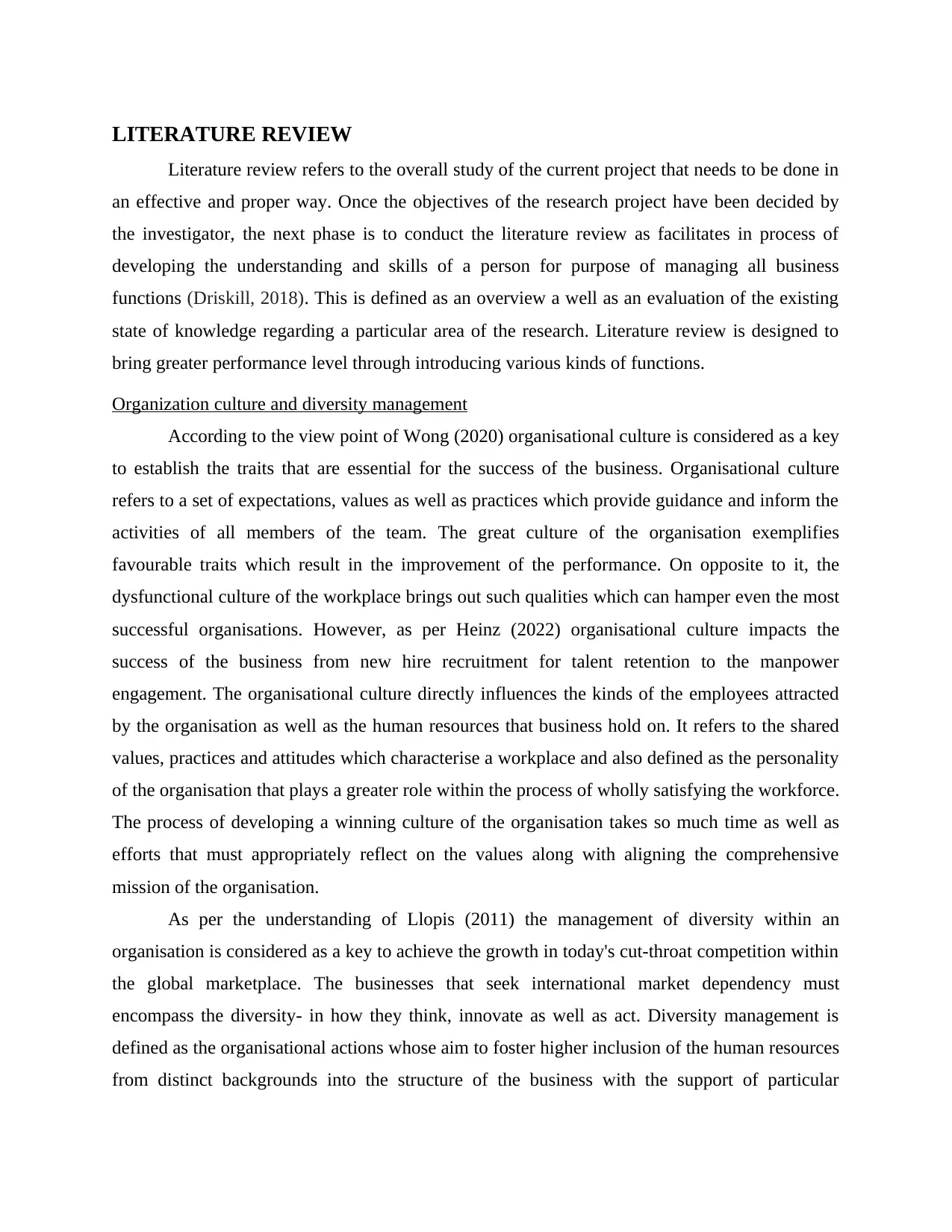
LITERATURE REVIEW
Literature review refers to the overall study of the current project that needs to be done in
an effective and proper way. Once the objectives of the research project have been decided by
the investigator, the next phase is to conduct the literature review as facilitates in process of
developing the understanding and skills of a person for purpose of managing all business
functions (Driskill, 2018). This is defined as an overview a well as an evaluation of the existing
state of knowledge regarding a particular area of the research. Literature review is designed to
bring greater performance level through introducing various kinds of functions.
Organization culture and diversity management
According to the view point of Wong (2020) organisational culture is considered as a key
to establish the traits that are essential for the success of the business. Organisational culture
refers to a set of expectations, values as well as practices which provide guidance and inform the
activities of all members of the team. The great culture of the organisation exemplifies
favourable traits which result in the improvement of the performance. On opposite to it, the
dysfunctional culture of the workplace brings out such qualities which can hamper even the most
successful organisations. However, as per Heinz (2022) organisational culture impacts the
success of the business from new hire recruitment for talent retention to the manpower
engagement. The organisational culture directly influences the kinds of the employees attracted
by the organisation as well as the human resources that business hold on. It refers to the shared
values, practices and attitudes which characterise a workplace and also defined as the personality
of the organisation that plays a greater role within the process of wholly satisfying the workforce.
The process of developing a winning culture of the organisation takes so much time as well as
efforts that must appropriately reflect on the values along with aligning the comprehensive
mission of the organisation.
As per the understanding of Llopis (2011) the management of diversity within an
organisation is considered as a key to achieve the growth in today's cut-throat competition within
the global marketplace. The businesses that seek international market dependency must
encompass the diversity- in how they think, innovate as well as act. Diversity management is
defined as the organisational actions whose aim to foster higher inclusion of the human resources
from distinct backgrounds into the structure of the business with the support of particular
Literature review refers to the overall study of the current project that needs to be done in
an effective and proper way. Once the objectives of the research project have been decided by
the investigator, the next phase is to conduct the literature review as facilitates in process of
developing the understanding and skills of a person for purpose of managing all business
functions (Driskill, 2018). This is defined as an overview a well as an evaluation of the existing
state of knowledge regarding a particular area of the research. Literature review is designed to
bring greater performance level through introducing various kinds of functions.
Organization culture and diversity management
According to the view point of Wong (2020) organisational culture is considered as a key
to establish the traits that are essential for the success of the business. Organisational culture
refers to a set of expectations, values as well as practices which provide guidance and inform the
activities of all members of the team. The great culture of the organisation exemplifies
favourable traits which result in the improvement of the performance. On opposite to it, the
dysfunctional culture of the workplace brings out such qualities which can hamper even the most
successful organisations. However, as per Heinz (2022) organisational culture impacts the
success of the business from new hire recruitment for talent retention to the manpower
engagement. The organisational culture directly influences the kinds of the employees attracted
by the organisation as well as the human resources that business hold on. It refers to the shared
values, practices and attitudes which characterise a workplace and also defined as the personality
of the organisation that plays a greater role within the process of wholly satisfying the workforce.
The process of developing a winning culture of the organisation takes so much time as well as
efforts that must appropriately reflect on the values along with aligning the comprehensive
mission of the organisation.
As per the understanding of Llopis (2011) the management of diversity within an
organisation is considered as a key to achieve the growth in today's cut-throat competition within
the global marketplace. The businesses that seek international market dependency must
encompass the diversity- in how they think, innovate as well as act. Diversity management is
defined as the organisational actions whose aim to foster higher inclusion of the human resources
from distinct backgrounds into the structure of the business with the support of particular
Paraphrase This Document
Need a fresh take? Get an instant paraphrase of this document with our AI Paraphraser
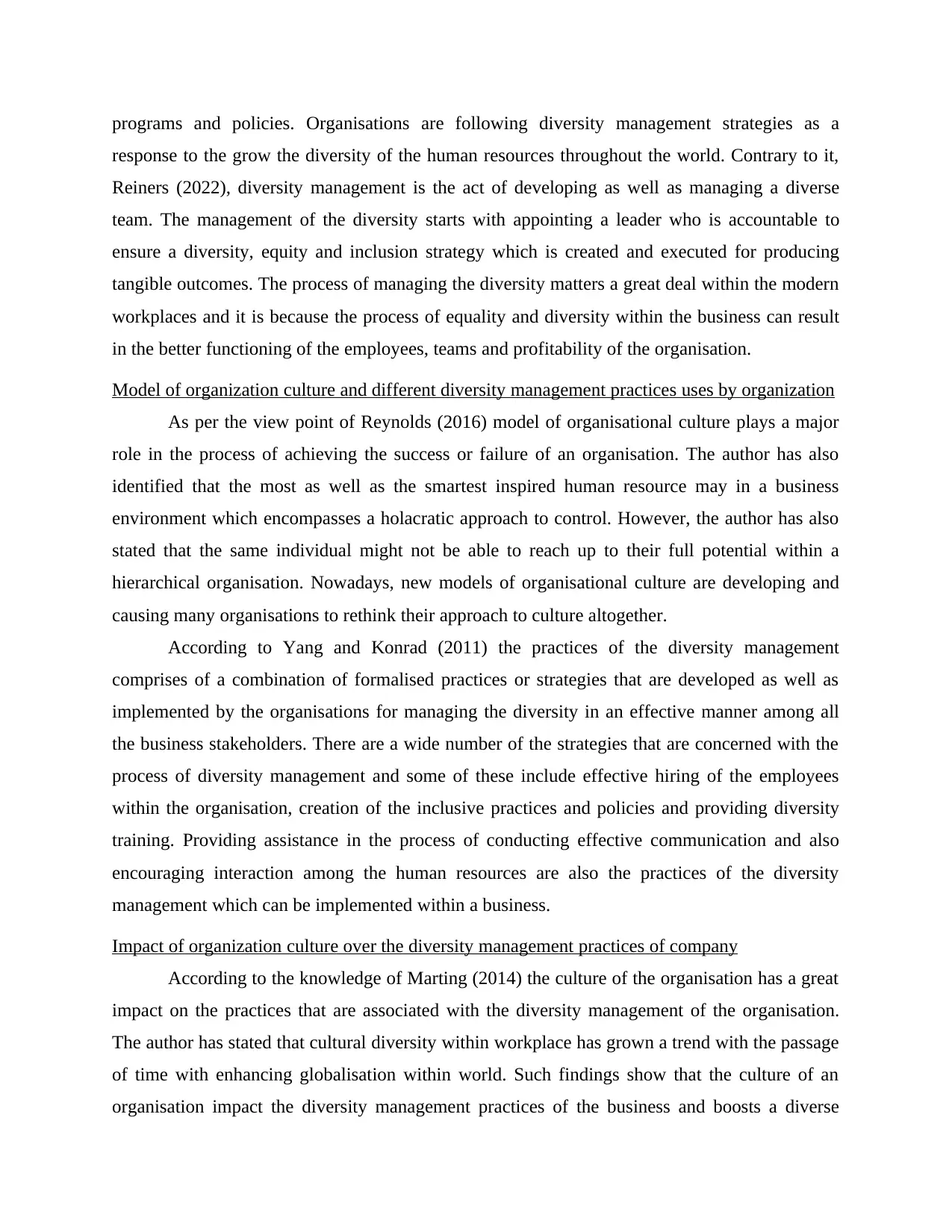
programs and policies. Organisations are following diversity management strategies as a
response to the grow the diversity of the human resources throughout the world. Contrary to it,
Reiners (2022), diversity management is the act of developing as well as managing a diverse
team. The management of the diversity starts with appointing a leader who is accountable to
ensure a diversity, equity and inclusion strategy which is created and executed for producing
tangible outcomes. The process of managing the diversity matters a great deal within the modern
workplaces and it is because the process of equality and diversity within the business can result
in the better functioning of the employees, teams and profitability of the organisation.
Model of organization culture and different diversity management practices uses by organization
As per the view point of Reynolds (2016) model of organisational culture plays a major
role in the process of achieving the success or failure of an organisation. The author has also
identified that the most as well as the smartest inspired human resource may in a business
environment which encompasses a holacratic approach to control. However, the author has also
stated that the same individual might not be able to reach up to their full potential within a
hierarchical organisation. Nowadays, new models of organisational culture are developing and
causing many organisations to rethink their approach to culture altogether.
According to Yang and Konrad (2011) the practices of the diversity management
comprises of a combination of formalised practices or strategies that are developed as well as
implemented by the organisations for managing the diversity in an effective manner among all
the business stakeholders. There are a wide number of the strategies that are concerned with the
process of diversity management and some of these include effective hiring of the employees
within the organisation, creation of the inclusive practices and policies and providing diversity
training. Providing assistance in the process of conducting effective communication and also
encouraging interaction among the human resources are also the practices of the diversity
management which can be implemented within a business.
Impact of organization culture over the diversity management practices of company
According to the knowledge of Marting (2014) the culture of the organisation has a great
impact on the practices that are associated with the diversity management of the organisation.
The author has stated that cultural diversity within workplace has grown a trend with the passage
of time with enhancing globalisation within world. Such findings show that the culture of an
organisation impact the diversity management practices of the business and boosts a diverse
response to the grow the diversity of the human resources throughout the world. Contrary to it,
Reiners (2022), diversity management is the act of developing as well as managing a diverse
team. The management of the diversity starts with appointing a leader who is accountable to
ensure a diversity, equity and inclusion strategy which is created and executed for producing
tangible outcomes. The process of managing the diversity matters a great deal within the modern
workplaces and it is because the process of equality and diversity within the business can result
in the better functioning of the employees, teams and profitability of the organisation.
Model of organization culture and different diversity management practices uses by organization
As per the view point of Reynolds (2016) model of organisational culture plays a major
role in the process of achieving the success or failure of an organisation. The author has also
identified that the most as well as the smartest inspired human resource may in a business
environment which encompasses a holacratic approach to control. However, the author has also
stated that the same individual might not be able to reach up to their full potential within a
hierarchical organisation. Nowadays, new models of organisational culture are developing and
causing many organisations to rethink their approach to culture altogether.
According to Yang and Konrad (2011) the practices of the diversity management
comprises of a combination of formalised practices or strategies that are developed as well as
implemented by the organisations for managing the diversity in an effective manner among all
the business stakeholders. There are a wide number of the strategies that are concerned with the
process of diversity management and some of these include effective hiring of the employees
within the organisation, creation of the inclusive practices and policies and providing diversity
training. Providing assistance in the process of conducting effective communication and also
encouraging interaction among the human resources are also the practices of the diversity
management which can be implemented within a business.
Impact of organization culture over the diversity management practices of company
According to the knowledge of Marting (2014) the culture of the organisation has a great
impact on the practices that are associated with the diversity management of the organisation.
The author has stated that cultural diversity within workplace has grown a trend with the passage
of time with enhancing globalisation within world. Such findings show that the culture of an
organisation impact the diversity management practices of the business and boosts a diverse
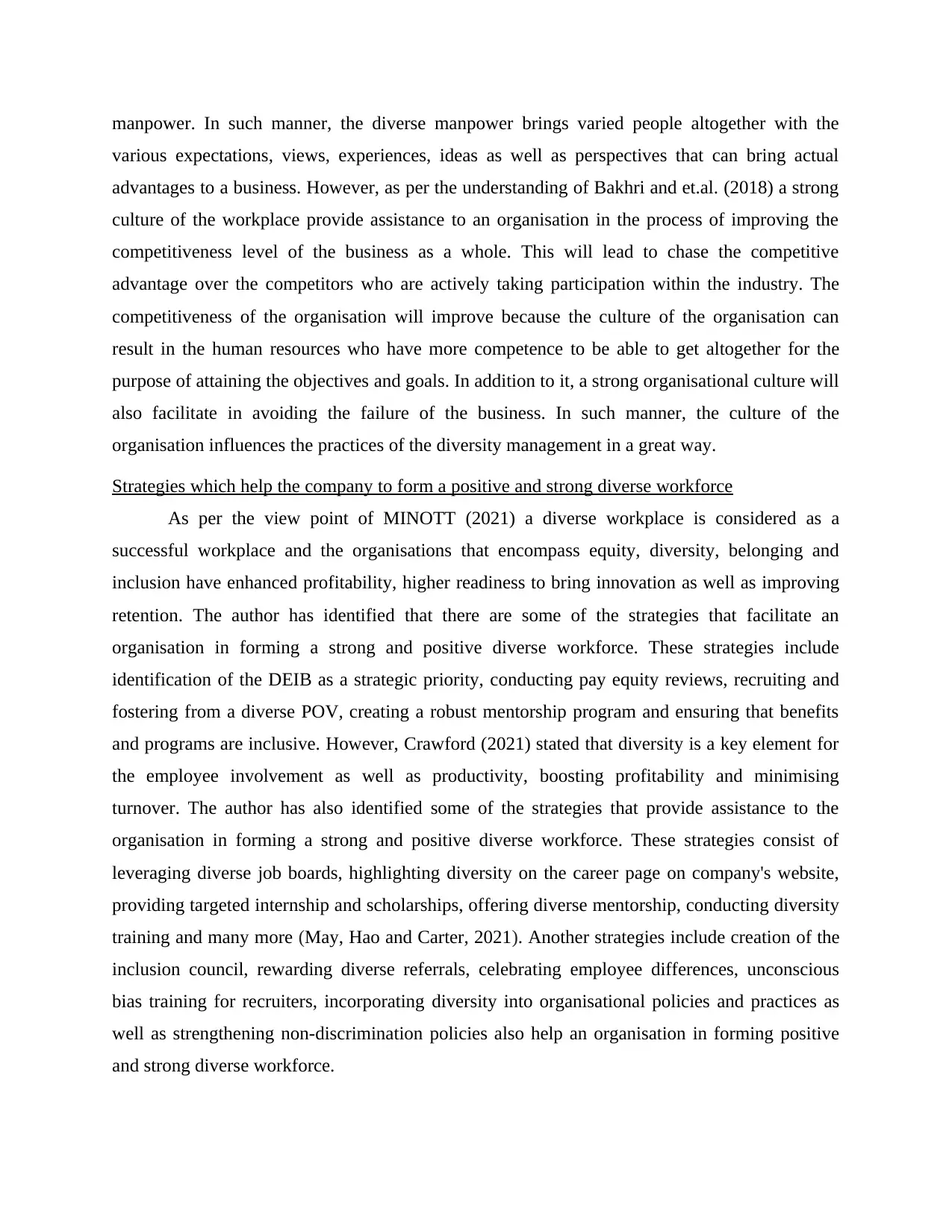
manpower. In such manner, the diverse manpower brings varied people altogether with the
various expectations, views, experiences, ideas as well as perspectives that can bring actual
advantages to a business. However, as per the understanding of Bakhri and et.al. (2018) a strong
culture of the workplace provide assistance to an organisation in the process of improving the
competitiveness level of the business as a whole. This will lead to chase the competitive
advantage over the competitors who are actively taking participation within the industry. The
competitiveness of the organisation will improve because the culture of the organisation can
result in the human resources who have more competence to be able to get altogether for the
purpose of attaining the objectives and goals. In addition to it, a strong organisational culture will
also facilitate in avoiding the failure of the business. In such manner, the culture of the
organisation influences the practices of the diversity management in a great way.
Strategies which help the company to form a positive and strong diverse workforce
As per the view point of MINOTT (2021) a diverse workplace is considered as a
successful workplace and the organisations that encompass equity, diversity, belonging and
inclusion have enhanced profitability, higher readiness to bring innovation as well as improving
retention. The author has identified that there are some of the strategies that facilitate an
organisation in forming a strong and positive diverse workforce. These strategies include
identification of the DEIB as a strategic priority, conducting pay equity reviews, recruiting and
fostering from a diverse POV, creating a robust mentorship program and ensuring that benefits
and programs are inclusive. However, Crawford (2021) stated that diversity is a key element for
the employee involvement as well as productivity, boosting profitability and minimising
turnover. The author has also identified some of the strategies that provide assistance to the
organisation in forming a strong and positive diverse workforce. These strategies consist of
leveraging diverse job boards, highlighting diversity on the career page on company's website,
providing targeted internship and scholarships, offering diverse mentorship, conducting diversity
training and many more (May, Hao and Carter, 2021). Another strategies include creation of the
inclusion council, rewarding diverse referrals, celebrating employee differences, unconscious
bias training for recruiters, incorporating diversity into organisational policies and practices as
well as strengthening non-discrimination policies also help an organisation in forming positive
and strong diverse workforce.
various expectations, views, experiences, ideas as well as perspectives that can bring actual
advantages to a business. However, as per the understanding of Bakhri and et.al. (2018) a strong
culture of the workplace provide assistance to an organisation in the process of improving the
competitiveness level of the business as a whole. This will lead to chase the competitive
advantage over the competitors who are actively taking participation within the industry. The
competitiveness of the organisation will improve because the culture of the organisation can
result in the human resources who have more competence to be able to get altogether for the
purpose of attaining the objectives and goals. In addition to it, a strong organisational culture will
also facilitate in avoiding the failure of the business. In such manner, the culture of the
organisation influences the practices of the diversity management in a great way.
Strategies which help the company to form a positive and strong diverse workforce
As per the view point of MINOTT (2021) a diverse workplace is considered as a
successful workplace and the organisations that encompass equity, diversity, belonging and
inclusion have enhanced profitability, higher readiness to bring innovation as well as improving
retention. The author has identified that there are some of the strategies that facilitate an
organisation in forming a strong and positive diverse workforce. These strategies include
identification of the DEIB as a strategic priority, conducting pay equity reviews, recruiting and
fostering from a diverse POV, creating a robust mentorship program and ensuring that benefits
and programs are inclusive. However, Crawford (2021) stated that diversity is a key element for
the employee involvement as well as productivity, boosting profitability and minimising
turnover. The author has also identified some of the strategies that provide assistance to the
organisation in forming a strong and positive diverse workforce. These strategies consist of
leveraging diverse job boards, highlighting diversity on the career page on company's website,
providing targeted internship and scholarships, offering diverse mentorship, conducting diversity
training and many more (May, Hao and Carter, 2021). Another strategies include creation of the
inclusion council, rewarding diverse referrals, celebrating employee differences, unconscious
bias training for recruiters, incorporating diversity into organisational policies and practices as
well as strengthening non-discrimination policies also help an organisation in forming positive
and strong diverse workforce.
⊘ This is a preview!⊘
Do you want full access?
Subscribe today to unlock all pages.

Trusted by 1+ million students worldwide
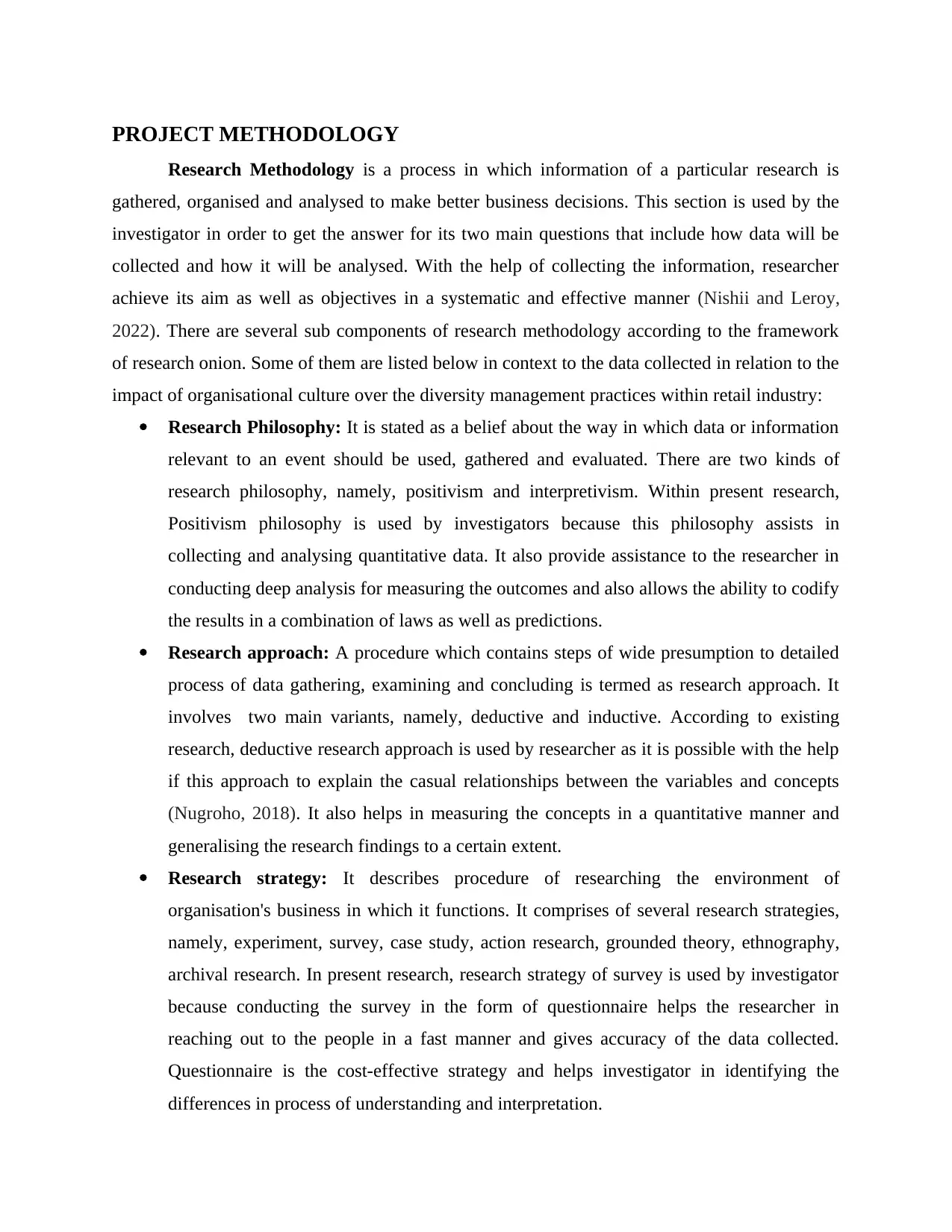
PROJECT METHODOLOGY
Research Methodology is a process in which information of a particular research is
gathered, organised and analysed to make better business decisions. This section is used by the
investigator in order to get the answer for its two main questions that include how data will be
collected and how it will be analysed. With the help of collecting the information, researcher
achieve its aim as well as objectives in a systematic and effective manner (Nishii and Leroy,
2022). There are several sub components of research methodology according to the framework
of research onion. Some of them are listed below in context to the data collected in relation to the
impact of organisational culture over the diversity management practices within retail industry:
Research Philosophy: It is stated as a belief about the way in which data or information
relevant to an event should be used, gathered and evaluated. There are two kinds of
research philosophy, namely, positivism and interpretivism. Within present research,
Positivism philosophy is used by investigators because this philosophy assists in
collecting and analysing quantitative data. It also provide assistance to the researcher in
conducting deep analysis for measuring the outcomes and also allows the ability to codify
the results in a combination of laws as well as predictions.
Research approach: A procedure which contains steps of wide presumption to detailed
process of data gathering, examining and concluding is termed as research approach. It
involves two main variants, namely, deductive and inductive. According to existing
research, deductive research approach is used by researcher as it is possible with the help
if this approach to explain the casual relationships between the variables and concepts
(Nugroho, 2018). It also helps in measuring the concepts in a quantitative manner and
generalising the research findings to a certain extent.
Research strategy: It describes procedure of researching the environment of
organisation's business in which it functions. It comprises of several research strategies,
namely, experiment, survey, case study, action research, grounded theory, ethnography,
archival research. In present research, research strategy of survey is used by investigator
because conducting the survey in the form of questionnaire helps the researcher in
reaching out to the people in a fast manner and gives accuracy of the data collected.
Questionnaire is the cost-effective strategy and helps investigator in identifying the
differences in process of understanding and interpretation.
Research Methodology is a process in which information of a particular research is
gathered, organised and analysed to make better business decisions. This section is used by the
investigator in order to get the answer for its two main questions that include how data will be
collected and how it will be analysed. With the help of collecting the information, researcher
achieve its aim as well as objectives in a systematic and effective manner (Nishii and Leroy,
2022). There are several sub components of research methodology according to the framework
of research onion. Some of them are listed below in context to the data collected in relation to the
impact of organisational culture over the diversity management practices within retail industry:
Research Philosophy: It is stated as a belief about the way in which data or information
relevant to an event should be used, gathered and evaluated. There are two kinds of
research philosophy, namely, positivism and interpretivism. Within present research,
Positivism philosophy is used by investigators because this philosophy assists in
collecting and analysing quantitative data. It also provide assistance to the researcher in
conducting deep analysis for measuring the outcomes and also allows the ability to codify
the results in a combination of laws as well as predictions.
Research approach: A procedure which contains steps of wide presumption to detailed
process of data gathering, examining and concluding is termed as research approach. It
involves two main variants, namely, deductive and inductive. According to existing
research, deductive research approach is used by researcher as it is possible with the help
if this approach to explain the casual relationships between the variables and concepts
(Nugroho, 2018). It also helps in measuring the concepts in a quantitative manner and
generalising the research findings to a certain extent.
Research strategy: It describes procedure of researching the environment of
organisation's business in which it functions. It comprises of several research strategies,
namely, experiment, survey, case study, action research, grounded theory, ethnography,
archival research. In present research, research strategy of survey is used by investigator
because conducting the survey in the form of questionnaire helps the researcher in
reaching out to the people in a fast manner and gives accuracy of the data collected.
Questionnaire is the cost-effective strategy and helps investigator in identifying the
differences in process of understanding and interpretation.
Paraphrase This Document
Need a fresh take? Get an instant paraphrase of this document with our AI Paraphraser
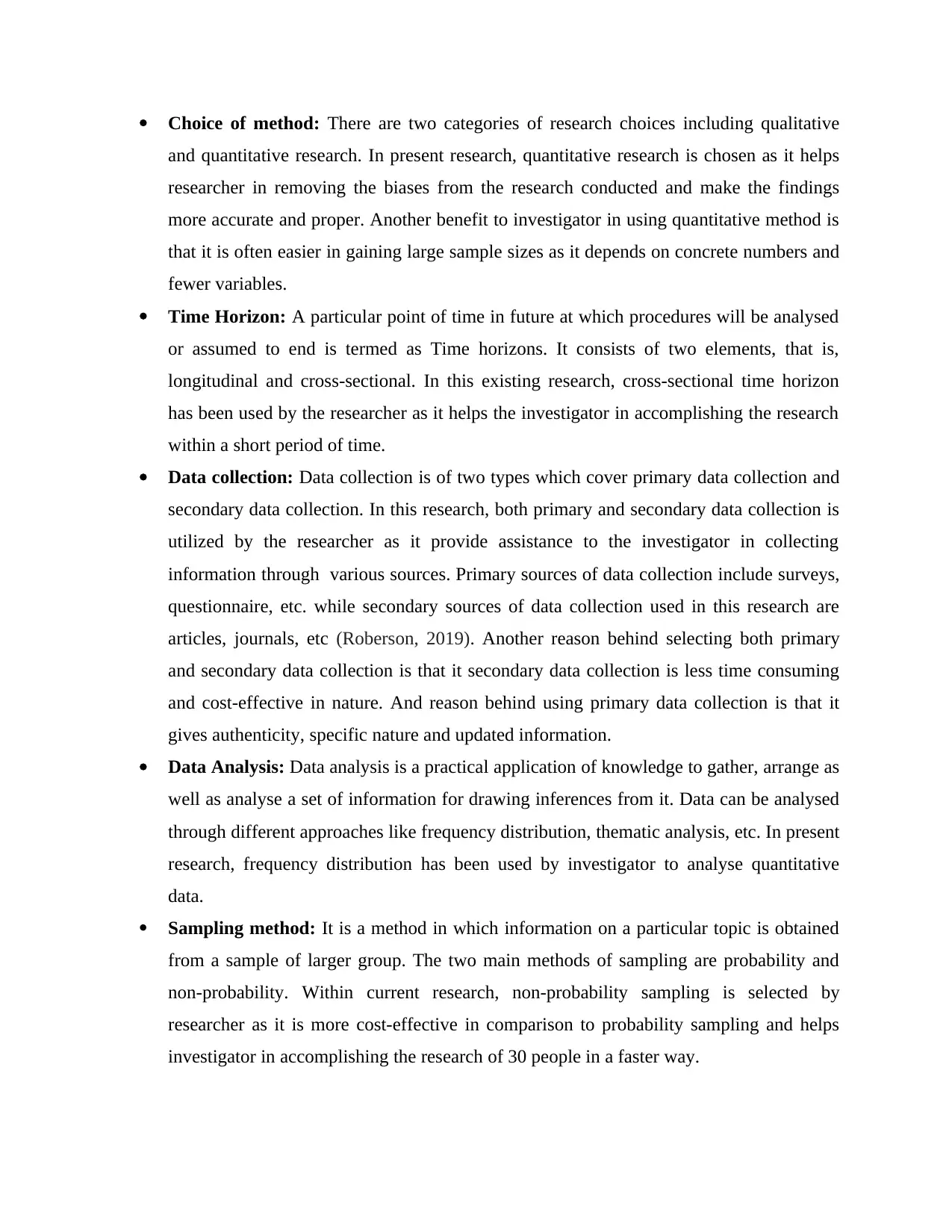
Choice of method: There are two categories of research choices including qualitative
and quantitative research. In present research, quantitative research is chosen as it helps
researcher in removing the biases from the research conducted and make the findings
more accurate and proper. Another benefit to investigator in using quantitative method is
that it is often easier in gaining large sample sizes as it depends on concrete numbers and
fewer variables.
Time Horizon: A particular point of time in future at which procedures will be analysed
or assumed to end is termed as Time horizons. It consists of two elements, that is,
longitudinal and cross-sectional. In this existing research, cross-sectional time horizon
has been used by the researcher as it helps the investigator in accomplishing the research
within a short period of time.
Data collection: Data collection is of two types which cover primary data collection and
secondary data collection. In this research, both primary and secondary data collection is
utilized by the researcher as it provide assistance to the investigator in collecting
information through various sources. Primary sources of data collection include surveys,
questionnaire, etc. while secondary sources of data collection used in this research are
articles, journals, etc (Roberson, 2019). Another reason behind selecting both primary
and secondary data collection is that it secondary data collection is less time consuming
and cost-effective in nature. And reason behind using primary data collection is that it
gives authenticity, specific nature and updated information.
Data Analysis: Data analysis is a practical application of knowledge to gather, arrange as
well as analyse a set of information for drawing inferences from it. Data can be analysed
through different approaches like frequency distribution, thematic analysis, etc. In present
research, frequency distribution has been used by investigator to analyse quantitative
data.
Sampling method: It is a method in which information on a particular topic is obtained
from a sample of larger group. The two main methods of sampling are probability and
non-probability. Within current research, non-probability sampling is selected by
researcher as it is more cost-effective in comparison to probability sampling and helps
investigator in accomplishing the research of 30 people in a faster way.
and quantitative research. In present research, quantitative research is chosen as it helps
researcher in removing the biases from the research conducted and make the findings
more accurate and proper. Another benefit to investigator in using quantitative method is
that it is often easier in gaining large sample sizes as it depends on concrete numbers and
fewer variables.
Time Horizon: A particular point of time in future at which procedures will be analysed
or assumed to end is termed as Time horizons. It consists of two elements, that is,
longitudinal and cross-sectional. In this existing research, cross-sectional time horizon
has been used by the researcher as it helps the investigator in accomplishing the research
within a short period of time.
Data collection: Data collection is of two types which cover primary data collection and
secondary data collection. In this research, both primary and secondary data collection is
utilized by the researcher as it provide assistance to the investigator in collecting
information through various sources. Primary sources of data collection include surveys,
questionnaire, etc. while secondary sources of data collection used in this research are
articles, journals, etc (Roberson, 2019). Another reason behind selecting both primary
and secondary data collection is that it secondary data collection is less time consuming
and cost-effective in nature. And reason behind using primary data collection is that it
gives authenticity, specific nature and updated information.
Data Analysis: Data analysis is a practical application of knowledge to gather, arrange as
well as analyse a set of information for drawing inferences from it. Data can be analysed
through different approaches like frequency distribution, thematic analysis, etc. In present
research, frequency distribution has been used by investigator to analyse quantitative
data.
Sampling method: It is a method in which information on a particular topic is obtained
from a sample of larger group. The two main methods of sampling are probability and
non-probability. Within current research, non-probability sampling is selected by
researcher as it is more cost-effective in comparison to probability sampling and helps
investigator in accomplishing the research of 30 people in a faster way.
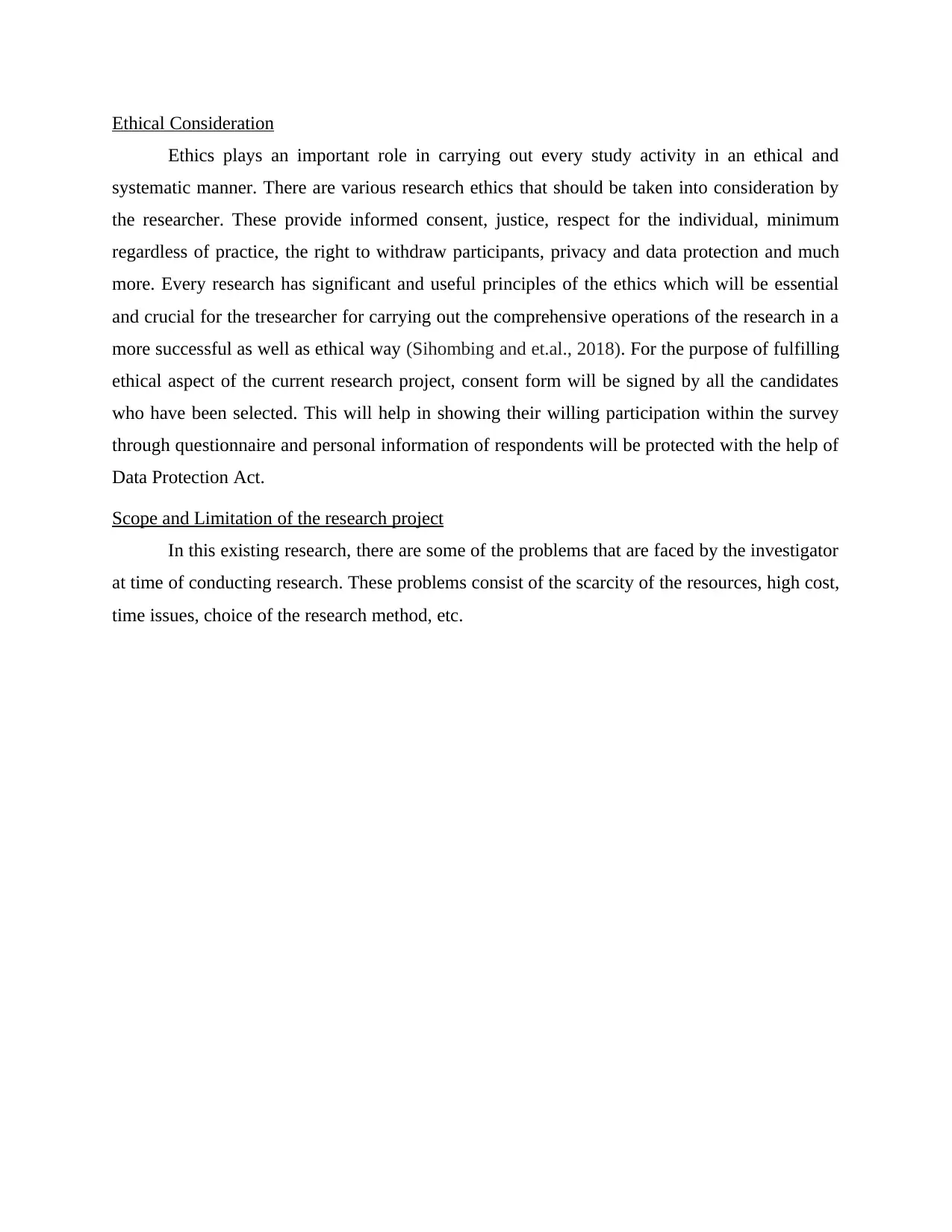
Ethical Consideration
Ethics plays an important role in carrying out every study activity in an ethical and
systematic manner. There are various research ethics that should be taken into consideration by
the researcher. These provide informed consent, justice, respect for the individual, minimum
regardless of practice, the right to withdraw participants, privacy and data protection and much
more. Every research has significant and useful principles of the ethics which will be essential
and crucial for the tresearcher for carrying out the comprehensive operations of the research in a
more successful as well as ethical way (Sihombing and et.al., 2018). For the purpose of fulfilling
ethical aspect of the current research project, consent form will be signed by all the candidates
who have been selected. This will help in showing their willing participation within the survey
through questionnaire and personal information of respondents will be protected with the help of
Data Protection Act.
Scope and Limitation of the research project
In this existing research, there are some of the problems that are faced by the investigator
at time of conducting research. These problems consist of the scarcity of the resources, high cost,
time issues, choice of the research method, etc.
Ethics plays an important role in carrying out every study activity in an ethical and
systematic manner. There are various research ethics that should be taken into consideration by
the researcher. These provide informed consent, justice, respect for the individual, minimum
regardless of practice, the right to withdraw participants, privacy and data protection and much
more. Every research has significant and useful principles of the ethics which will be essential
and crucial for the tresearcher for carrying out the comprehensive operations of the research in a
more successful as well as ethical way (Sihombing and et.al., 2018). For the purpose of fulfilling
ethical aspect of the current research project, consent form will be signed by all the candidates
who have been selected. This will help in showing their willing participation within the survey
through questionnaire and personal information of respondents will be protected with the help of
Data Protection Act.
Scope and Limitation of the research project
In this existing research, there are some of the problems that are faced by the investigator
at time of conducting research. These problems consist of the scarcity of the resources, high cost,
time issues, choice of the research method, etc.
⊘ This is a preview!⊘
Do you want full access?
Subscribe today to unlock all pages.

Trusted by 1+ million students worldwide
1 out of 30
Related Documents
Your All-in-One AI-Powered Toolkit for Academic Success.
+13062052269
info@desklib.com
Available 24*7 on WhatsApp / Email
![[object Object]](/_next/static/media/star-bottom.7253800d.svg)
Unlock your academic potential
Copyright © 2020–2025 A2Z Services. All Rights Reserved. Developed and managed by ZUCOL.




